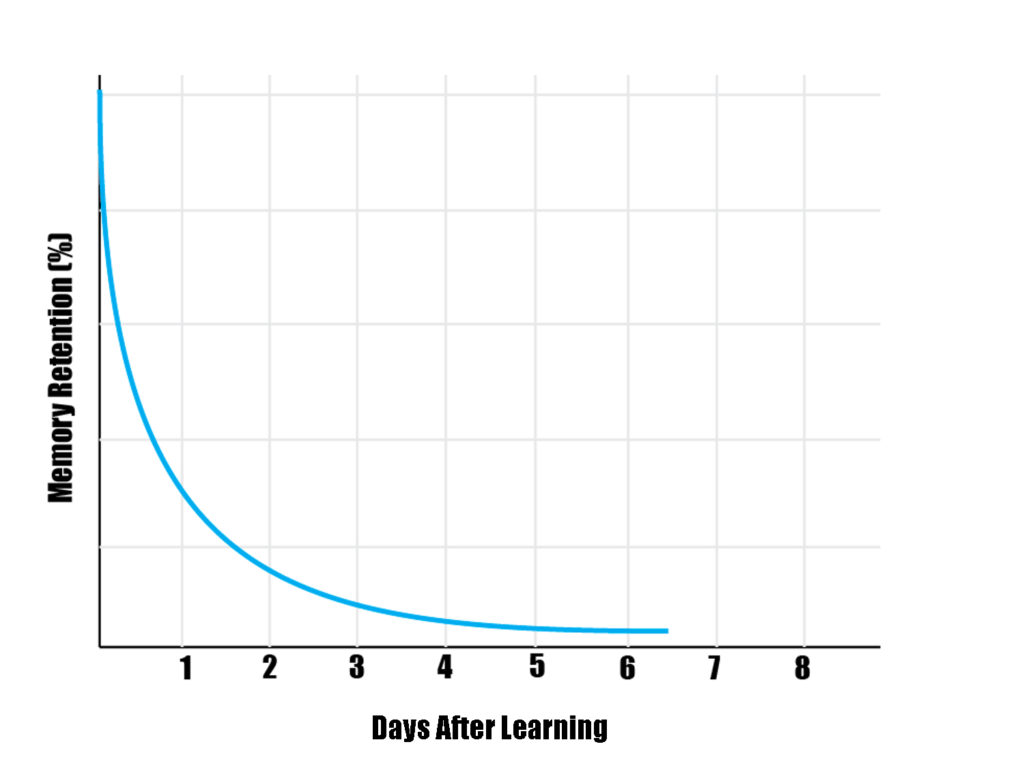I graduated from Gonzaga University in 2010. While there, I took two years of Italian, studied abroad in Florence for 8 months, and then lived and worked in Italy for 4 months after graduation. I was practically fluent in Italian as a result. In fact, Italian used to be a skill I listed on my resume in the hopes that knowing a second language would give me a leg up on other candidates.
Today, if you asked me how to say something in Italian, I wouldn’t be able to tell you anything as I’ve practically lost everything I learned. In fact, I’m currently starting over in a beginner Italian class. Although that bums me out, I shouldn’t be surprised. Here’s why.
The forgetting curve
The human brain makes room for more relevant information by forgetting information. It’s that simple. There’s only room for so much knowledge. While this sounds like a good thing, we don’t have much control over the information our brain chooses to retain or forget. This is problematic and explains why we seem to be able to remember every word to a song we were obsessed with and haven’t heard since the 6th grade, but not remember a statistic we heard on the news last week.

The brain prioritizes the information it retains using these criteria: repetition, primacy and recency, surprise, and emotional impact.
Repetition
Repetition is the reason we remember the words to our favorite song from 6th grade. We probably played that song over and over again. So much so that our brain has assigned it a high level of importance.
Primacy and recency
The first and most recent things are often most remembered. This is why some salespeople use the sandwich method in their sales pitches – they want you to remember the first and last things they said. If you’re going to forget one thing, they want it to be the middle topic.
Surprise
Your brain is likely to remember anything that is unusual or stands out. This is a technique that teachers often use in science experiments. Students will make predictions, they’ll conduct an experiment, and the surprising outcome will make the principles of what they learned more memorable.
Emotional impact
Emotions tap into our survival instincts. Anything with a high emotional impact is typically retained for a long time. After a car accident, people often express that it felt like time slowed down leading up to the crash. This is because the brain is recording a lot of details to later remember.
Combatting the curve
Whether you’re a Marketing Director relearning Italian or an engineer designing Elon Musk’s underground tunnel, no one is exempt from forgetting.
To help increase your chances of remembering, it’s important to implement milestones, also called booster events, after learning. Milestones/booster events are ways to reinforce the information your brain just took in. These events are pivotal when it comes time for your brain to prioritize information. The amount of information you retain increases after each of these milestones.

Creating milestones after learning
Through my job at SolidProfessor and my first-hand experience relearning Italian, I’d like to share four tips for creating these milestones and therefore retaining information.
Cognitive reinforcement
After every Italian class, we’re assigned homework. The point of homework is to reinforce what we learned in class. However, HOW that’s reinforced is important. Rather than answering multiple choice questions, our homework typically consists of writing out answers or describing things in Italian. There’s nothing to help guide us towards an answer with this type of reinforcement, forcing us to really recall what we learned in class. The brain registers this as repetition and prioritizes it accordingly.
Social reinforcement
When I lived in Italy, I would learn Italian in class and then go to a restaurant or cafe and be surrounded by people speaking Italian. I was surrounded by a community of Italian speakers. When I moved back to the US, that community didn’t exist and Italian was no longer something I heard or spoke often. Without that community and social reinforcement, my brain designated the language a lower priority and something that was okay to forget. I lost the emotional impact.
Behavioral reinforcement
After I learned Italian, did I put it to use? When I lived in Italy, I did. After that, I did not. It’s important to practice and put to use the things we learn if we want to remember them. For example, if I learned every grammar rule and every Italian word, but never actually spoke Italian out loud, I probably wouldn’t be very good.
Depend on your ability to relearn
After implementing the above three tips, if you still can’t quite remember, depend on your brain’s ability to quickly relearn. You may not remember all the words to your favorite song from the sixth grade. But, if that song came on in the car, the words would likely come flooding back to you. Your brain has the amazing ability to quickly relearn – depend on this. The easiest way to do this is to have a reference tool on hand. The more times you reference that same information, the more recent that information becomes, and you’ll be more likely to remember the next time.
In the end, our brains are powerful and we can train them to remember the things we want to retain. I’ve successfully implemented these strategies with my own relearning of Italian and encourage others to give them a try too.
























